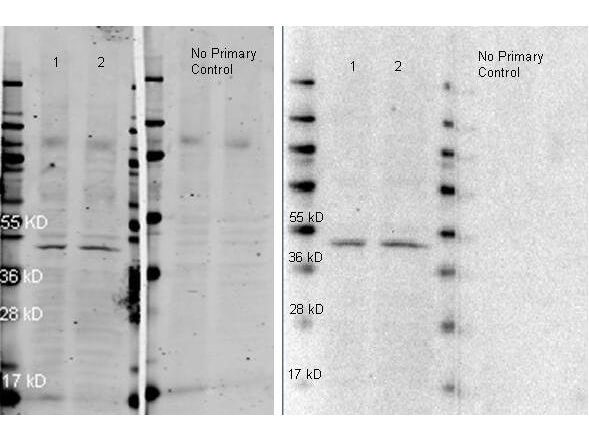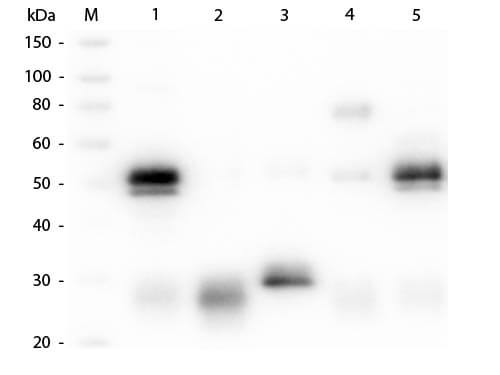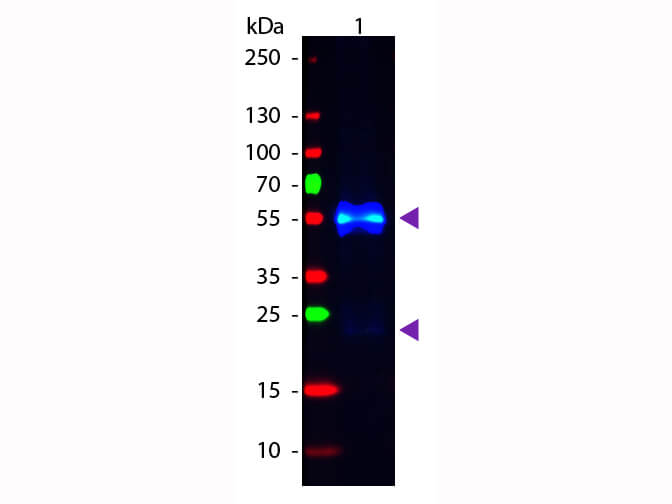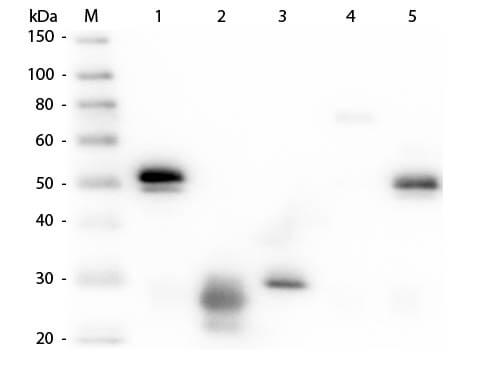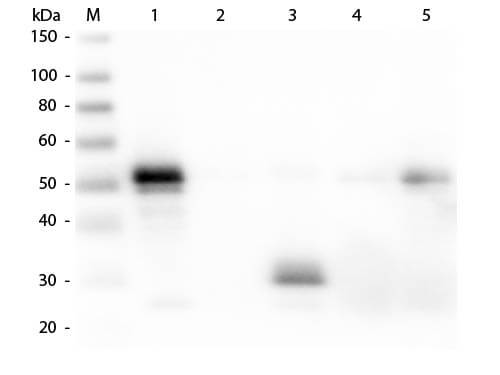Datasheet is currently unavailable. Try again or CONTACT US
Rabbit IgG (H&L) Antibody ATTO 647N Conjugated Pre-Adsorbed
Goat Polyclonal
19 References
611-156-122S
611-156-122
100 µg
500 µg
Lyophilized
Lyophilized
WB, IHC, IF, Dot Blot, Multiplex
Rabbit
Goat
Shipping info:
$50.00 to US & $70.00 to Canada for most products. Final costs are calculated at checkout.
Product Details
Goat Anti-Rabbit IgG (H&L) Antibody ATTO 647N Conjugated (Min X Bv Ch Gt GP Ham Hs Hu Ms Rt & Sh Serum Proteins) - 611-156-122
Goat anti-Rabbit IgG Antibody ATTO647N Conjugation, Goat anti-Rabbit IgG ATTO 647N Conjugated Antibody
Goat
IgG (H&L)
ATTO 647N
Polyclonal
IgG
Target Details
Rabbit
Rabbit IgG whole molecule
Rabbit IgG (H&L) Antibody ATTO 647N was prepared from monospecific antiserum by immunoaffinity chromatography using Rabbit IgG coupled to agarose beads followed by solid phase adsorption(s) to remove any unwanted reactivities. Assay by immunoelectrophoresis resulted in a single precipitin arc against anti-Goat Serum, Rabbit IgG and Rabbit Serum. No reaction was observed against Bovine, Chicken, Goat, Guinea Pig, Hamster, Horse, Human, Mouse, Rat and Sheep Serum Proteins. This antibody will react with heavy chains of rabbit IgG and with light chains of most rabbit immunoglobulins.
Application Details
Dot Blot, WB
IF, IHC, Multiplex
- View References
Anti-Rabbit IgG (H&L) conjugated to ATTO 647N has been tested by dot blot and western blot and is designed for STED microscopy, FRET, immunofluorescence microscopy, fluorescence based plate assays (FLISA) and fluorescent western blotting. This product is also suitable for multiplex analysis, including multicolor imaging, utilizing various commercial platforms. The emission spectra for this ATTO conjugate matches the principle output wavelengths of most common fluorescence instrumentation.
Formulation
1.0 mg/mL by UV absorbance at 280 nm
0.02 M Potassium Phosphate, 0.15 M Sodium Chloride, pH 7.2
0.01% (w/v) Sodium Azide
10 mg/mL Bovine Serum Albumin (BSA) - Immunoglobulin and Protease free
500 µL
Restore with deionized water (or equivalent)
Shipping & Handling
Ambient
Store vial at 4° C prior to restoration. For extended storage aliquot contents and freeze at -20° C or below. Avoid cycles of freezing and thawing. Centrifuge product if not completely clear after standing at room temperature. This product is stable for several weeks at 4° C as an undiluted liquid. Dilute only prior to immediate use.
Expiration date is one (1) year from date of receipt.
Anti-Rabbit IgG (H&L) ATTO 647N Antibody generated in goat detects reactivity to Rabbit IgG. Secreted as part of the adaptive immune response by plasma B cells, immunoglobulin G constitutes 75% of serum immunoglobulins. Immunoglobulin G binds to viruses, bacteria, as well as fungi and facilitates their destruction or neutralization via agglutination (and thereby immobilizing them), activation of the compliment cascade, and opsonization for phagocytosis. The whole IgG molecule possesses both the F(c) region, recognized by high-affinity Fc receptor proteins, as well as the F(ab) region possessing the epitope-recognition site. Both the Heavy and Light chains of the antibody molecule are present. Secondary Antibodies are available in a variety of formats and conjugate types. When choosing a secondary antibody product, consideration must be given to species and immunoglobulin specificity, conjugate type, fragment and chain specificity, level of cross-reactivity, and host-species source and fragment composition.
Lavogina D et al. (2024). Inhibition of epigenetic and cell cycle-related targets in glioblastoma cell lines reveals that onametostat reduces proliferation and viability in both normoxic and hypoxic conditions. Sci Rep.
Applications
IF, Confocal Microscopy
Chen J et al. (2023). Integrative transcriptomics and cell systems analyses reveal protective pathways controlled by Igfbp-3 in anthracycline-induced cardiotoxicity. FASEB J.
Applications
IF, Confocal Microscopy
Pearson-Smith JN et al. (2023). Neuronal SIRT3 Deletion Predisposes to Female-Specific Alterations in Cellular Metabolism, Memory, and Network Excitability. J Neurosci.
Applications
IHC, ICC, Histology
Puchov D et al. (2023). Analyzing the cellular plasma membrane by fast and efficient correlative STED and platinum replica EM. Front Cell Dev Biol.
Applications
IF, Confocal Microscopy
Krause GJ et al. (2023). Molecular determinants of the crosstalk between endosomal microautophagy and chaperone-mediated autophagy. Cell Rep.
Applications
IF, Confocal Microscopy
Smith, AJ et al. (2022). GATD3A, a mitochondrial deglycase with evolutionary origins from gammaproteobacteria, restricts the formation of advanced glycation end products. Bmc Biology
Applications
IF, Confocal Microscopy
Hruska M et al. (2022). Nanoscale rules governing the organization of glutamate receptors in spine synapses are subunit specific. Nat Commun.
Applications
IF, Confocal Microscopy
Matthaeus C et al. (2022). The molecular organization of differentially curved caveolae indicates bendable structural units at the plasma membrane. Nat Commun.
Applications
IF, Confocal Microscopy
Scott, WA et al. (2021). ATRX proximal protein associations boast roles beyond histone deposition. PloS Genetics
Applications
IF, Confocal Microscopy
Cruz-Zaragoza LD et al. (2021). An in vitro system to silence mitochondrial gene expression. Cell.
Applications
IF, Confocal Microscopy
Kunz TC. et al. (2020). Using Expansion Microscopy to visualize and characterize the morphology of mitochondrial cristae. Front Cell Dev Biol.
Applications
IF, Confocal Microscopy
Ivanova D et al. (2020). CtBP1-mediated membrane fission contributes to effective recycling of synaptic vesicles. Cell Rep.
Applications
IF, Confocal Microscopy
Richter KN et al. (2018). Comparative synaptosome imaging: a semi-quantitative method to obtain copy numbers for synaptic and neuronal proteins. Sci Rep.
Applications
IF, Confocal Microscopy
Hruska et al. (2018). Synaptic nanomodules underlie the organization and plasticity of spine synapses. Nature Neuroscience
Applications
IF, Confocal Microscopy
Truckenbrodt et al. (2018). Newly produced synaptic vesicle proteins are preferentially used in synaptic transmission. The EMBO Journal
Applications
IHC, ICC, Histology
Purkey AM et al. (2018). AKAP150 palmitoylation regulates synaptic incorporation of Ca2+-permeable AMPA receptors to control LTP. Cell Rep.
Applications
IF, Confocal Microscopy
Gomes de Castro et al. (2017). Aptamers provide superior stainings of cellular receptors studied under super-resolution microscopy. PLOS One
Applications
IF, Confocal Microscopy; Multiplex Assay
Scholefield, J et al. (2016). Super-resolution microscopy reveals a preformed NEMO lattice structure that is collapsed in incontinentia pigmenti. Nature Communications
Applications
IF, Confocal Microscopy
Saka, SK et al. (2014). Correlated optical and isotopic nanoscopy. Nature Communications
Applications
IF, Confocal Microscopy
This product is for research use only and is not intended for therapeutic or diagnostic applications. Please contact a technical service representative for more information. All products of animal origin manufactured by Rockland Immunochemicals are derived from starting materials of North American origin. Collection was performed in United States Department of Agriculture (USDA) inspected facilities and all materials have been inspected and certified to be free of disease and suitable for exportation. All properties listed are typical characteristics and are not specifications. All suggestions and data are offered in good faith but without guarantee as conditions and methods of use of our products are beyond our control. All claims must be made within 30 days following the date of delivery. The prospective user must determine the suitability of our materials before adopting them on a commercial scale. Suggested uses of our products are not recommendations to use our products in violation of any patent or as a license under any patent of Rockland Immunochemicals, Inc. If you require a commercial license to use this material and do not have one, then return this material, unopened to: Rockland Inc., P.O. BOX 5199, Limerick, Pennsylvania, USA.


